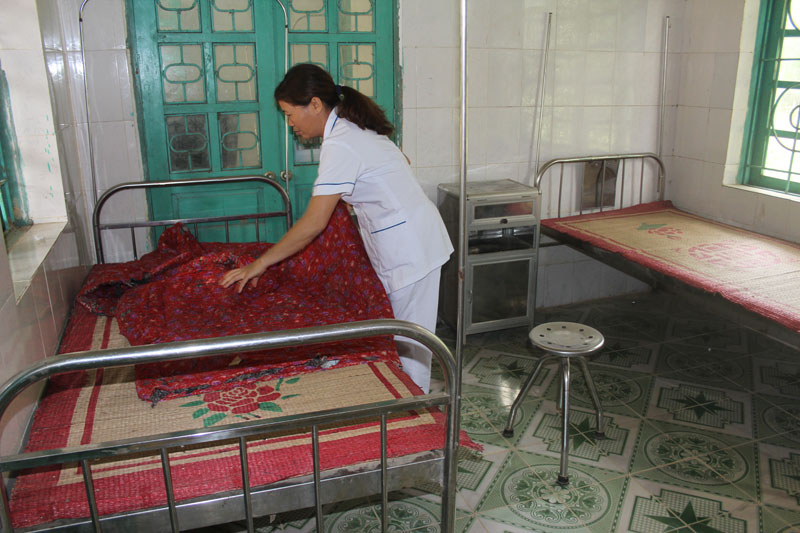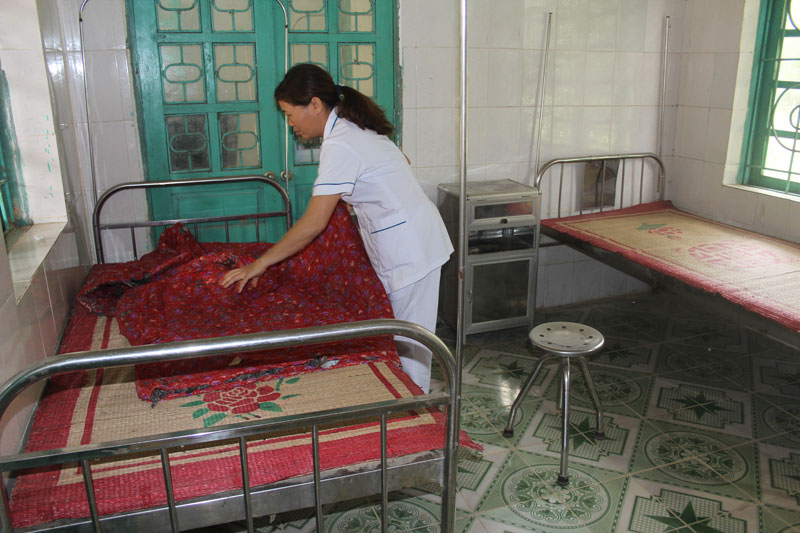
(HBO) - From the center of the district about more than 20 km, Tu Do commune is the deepest remote commune of Lac Son district with a lot of difficulties. The Commune Health Center was built in 2003 but due to its low and flooded location area, the facilities were degraded and they did not meet the demand of medical examination and treatment for 2,608 local people in the commune.

The cramped cessation ward of Tu Do Commune
Health Center (Lac Son) affects the medical examination and treatment.
Mr. Bui Van Manh, the Head of Tu Do Commune
Health Center said: The first rainy season which lasted just over 1 hour has
flooded the yard of the center. Patients coming there had to wade in water. If
the rain had lasted about 30 minutes more, the water would have flooded into
the floor inside. Almost every year, the center has been flooded several times,
and once the medicine cabinets were caught wet. Due to submergence, most of the
walls were scaling off and moss - grown. The reason is because the center
construction is located in the valley, surrounded by hills and mountains. The
drainage is in a small rock cave, so the drain is too slow. The center location
is not much higher than the drainage, so when the rain is continuous and heavy,
it causes local flooding. Outside of the campus, there was no investment in
fencing and surroundings, people freely moved through the center. Over the
time, many people often grazed cattle and buffaloes in the campus of the
center, causing unhygienic damage to the medical examination and treatment. To
avoid this situation, on the days off, the center has mobilized staff to use
branches for fencing and building a temporary gate to prevent the cattle from
entering.
Taking us to visit the center, Mr. Manh
added: Because the traffic is difficult, most of the medical examination and
treatment of the local people in the commune are done by this treatment center.
Only too heavy cases will be transferred to the higher level hospitals.
Annually, the center holds the medical examination and treatment for over 2,000
people. Apart from the medical examination and treatment function, the center
also implements health programs of the sector. About the facilities, the center
was built in 2003 with 8 functional rooms. Most of the room doors are open so
it affects the examination and treatment, especially the sterile during the
procedure.
The emulation movement "Hoa Binh joining hands to build new-style rural areas” has been widely spreading, becoming a driving force that motivates the localities to renew rural landscapes and improve the material and spiritual lives of the residents. In this movement, the people play a central role-both as the main implementers and direct beneficiaries of its outcomes.
In response to the global digital revolution, Hoa Binh Newspaper is transforming itself into a modern and multi-platform media hub, blending cutting-edge technology with a restructured newsroom and a new generation of tech-savvy journalists.
Hoa Binh province’s Association of the Elderly recently held a conference to review the project on expanding the inter-generation self-help club model until 2025.
In a move to implement Resolution No. 57-NQ/TW, issued on December 22, 2024 by the Politburo, which targets breakthroughs in science-technology development, innovation, and digital transformation, the Hoa Binh provincial Department of Health has issued a plan to roll out the "Digital Literacy for All” campaign within the local health sector.
An Nghia Commune (Lạc Sơn District) is one of the communes that achieved the tha standard of the national new rural area in 2018. Entering a new development phase, the commune is now trying to meet the criteria for the advanced new rural development. With the strong political will and the public consensus, the commune is gradually overcoming the challenges to reach this goal, aiming for the sustainable development.



